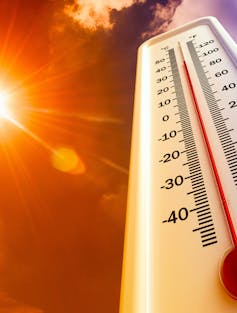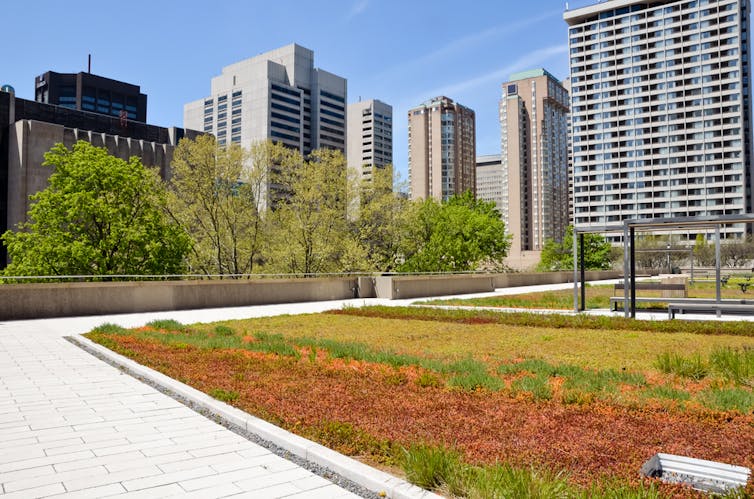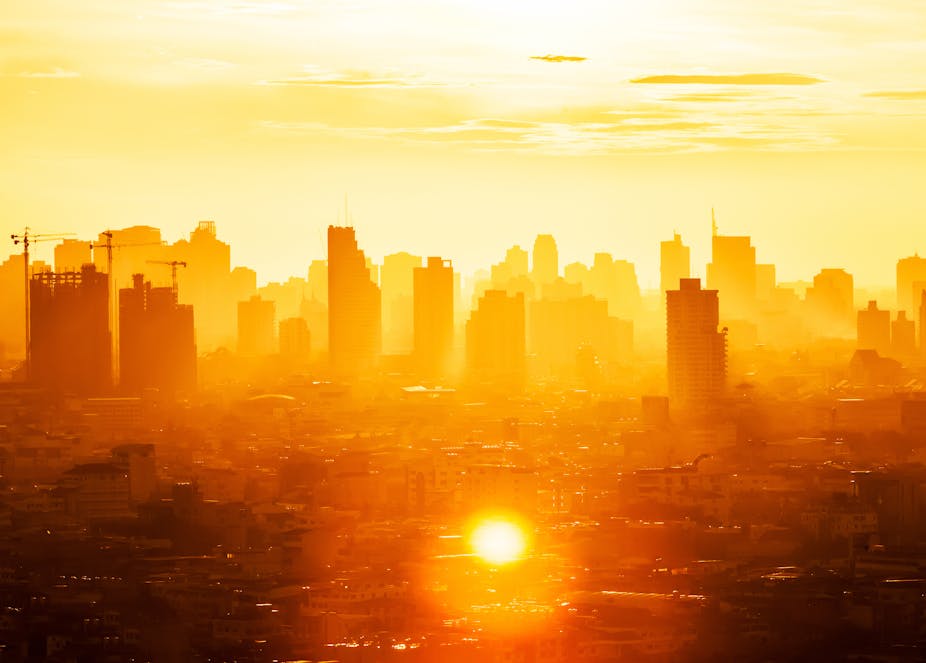You walk through a park in a city on a warm day, then cross out to a narrow street lined with tall buildings. Suddenly, it feels much hotter. Many people will have experienced this, and climate scientists have a name for it: the urban heat island effect.
Heavily urbanised areas within cities are between 1°C and 3°C hotter than other areas. They are contributing to global warming and damaging people’s health, and it’s set to get worse as urbanisation intensifies.
Numerous cities around the world are trying to do something about this problem. But there is a very long way to go. So what is holding us back, and what needs to happen?
Urban heat relates to how most cities have been designed. Many rows of tall buildings are organised into blocks which resist any natural breeze. Streets and roofs are clad in dark materials like asphalt and bitumen, which retain more heat than lighter materials and natural surfaces like soil.

Natural ground absorbs rain, which is evaporated by the sun’s rays on a warm day and released into the air, cooling everything down. In a city, the rain just runs into the sewer system instead.
Urban areas tend to lack trees. Trees help reduce the air temperature by blocking the sun’s rays, while cutting the levels of pollution by absorbing harmful particles.
Cities are also warmer because they are full of human activity. Everything from transport to industry to energy output makes them hotter than they otherwise would be.
Cause and effect
Urban heat has various consequences. Combined with heatwaves and global warming, both of which are also on the rise, these hotspots are producing conditions that kill and hospitalise growing numbers of people. The worst affected are the elderly and other vulnerable groups like the homeless.
The World Health Organisation (WHO) has warned that increased city temperatures lead to more pollutants in the air. These can aggravate respiratory diseases, particularly among children. As cities get bigger, more and more people will be affected by these threats to their health.

Higher city temperatures are one reason why we are using more and more air conditioning. One US study found that the urban heat island effect in Florida was responsible for over $400m (£287m) of extra aircon, for example.
Aircon feeds climate change by producing more carbon emissions through the extra electricity demand, creating a vicious circle where it gets hotter because more aircon is required. The increased energy demand means a greater risk of summer blackouts, causing both human discomfort and economic damage.
Hotter city roads and pavements also raise the temperature of storm-water runoff in sewers. This in turn makes rivers and lakes warmer, which can affect fish and other aquatic species in relation to things like feeding and reproduction.
Finally, there are major economic consequences to hotter cities. One paper from last year predicts that all the extra wear and tear caused by the excess heat would amount to between 1% and 10% of lost GDP in thousands of cities around the world.
How we’re reacting
The solutions to the problem are clear enough: they include using paler more reflective building materials, and wiser urban planning that incentivises more parks, tree planting and other natural open spaces.
When it comes to taking these steps, however, it’s a very mixed picture. Countries and municipal authorities have typically become very good at adopting plans to cut emissions of carbon dioxide and other greenhouse gases. They are not so good at taking steps to adapt to climate change. A study from 2014 found that most European cities had failed to introduce urban heat plans, and the situation looks little better today.
This being the case, city administrations that have gone the extra mile look particularly enlightened – even though they tend to be somewhat sporadic. Melbourne, for instance, has substituted its trademark bluestone pavements in several areas with a permeable version that absorbs rainwater, thereby increasing the amount of evaporation.
New York City’s Cool Roof Initiative has seen thousands of volunteers painting some of the city’s flat bituminous roofs with a reflective polymer material. Lately, Los Angeles has launched an initiative to paint roads white, part of a pledge by city hall to lower the temperature by 3°C in the next 20 years. Beijing, meanwhile, has been introducing zoning measures to reduce smog.
Other administrations have been encouraging green roofs – rooftops covered in vegetation: they are a legal requirement for big new developments in Toronto; there are floor area bonuses for developers who include them in Portland, Oregon; and Chicago had a funding scheme for a while. In Swiss cities and regions, green roofs have been a legal requirement for many buildings for years.

These are all just pockets of activity, however. Many other mayors and city administrations need to start implementing the kinds of bylaws and incentives to adapt to the reality of hotter cities.
The cities of the future can still be green and cool, but only if they move up the agendas of many city halls. The laggards need to follow the example of those that have been leading the way. The reality is that the social, environmental and economic costs of urban heat islands add up to a bill that is too high for humanity to pay.

